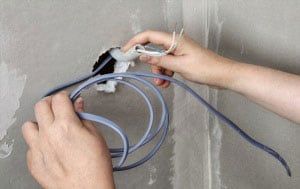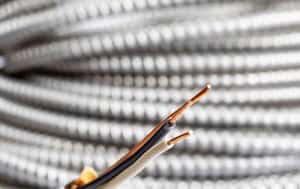A 30 amp circuit will give more electricity compared to the usual 15 or 20 amp circuits at home. In fact, this type of setup is good for a generator, a dryer, or an RV.
Suppose you already have one of these items and need to protect it against electrical faults. In that case, learn how to install a 30 amp breaker here.
With the appropriate 10 gauge wire, the right breaker, and a compatible receptacle, installing a 30 amp breaker and its circuit can be your DIY project. Follow this guide for more details.
Table of Contents
- What to Prepare
- Step-by-Step Instructions
- Step 1. Check for available circuit breaker slots in your panel.
- Step 2. Thread the electrical wire from the panel to the outlet.
- Step 3. Mount the outlet box in your desired location and install a 30 amp outlet in the box.
- Step 4. Run the cable into the main panel.
- Step 5. Connect the neutral and ground wires at the panel.
- Step 6. Connect the hot wires to the breaker.
- Step 7. Close the panel
- FAQs
- Conclusion
What to Prepare
We must choose the right items to hook up a 30 amp breaker.
30A, 120V single pole breakers are fine for a camper or RV charging setup, while 30 amp double pole breakers used for 240 volts are good for a dryer. Take note that you may hire an electrician if you do not want to do the installation by yourself.
This guide focuses on a connection where the breakers are separate from the main electrical panel. A 30 amp RV outlet box with breaker is available in the market, so it should be easy to get one. If you choose to buy these 30 amp breaker boxes, please follow the instructions that come with them.
Read more about “What is the Difference Between Single Pole and Double Pole”.
120 volt circuit for RV charging
- 120 volt 30 amp single pole breaker
- 10-2 cable (10 gauge with 2 conducting wires and 1 ground)
- 30 amp 120 volt receptacle and outlet box for RV
240 volt circuit for dryers
- 240 volt 30 amp breaker (double pole)
- Laundry areas must use circuit breakers with arc fault (CAFI) or ground fault (GFCI) protection
- 10-3 cable (10 gauge with 3 conducting wires and 1 ground)
- 30 amp 240 volt receptacle and outlet box
Other tools
- Cable clamp
- Cable staple
- Wire stripper
- Screwdriver
- Drill or hole saw
- External electrical source
Step-by-Step Instructions
Step 1. Check for available circuit breaker slots in your panel.
Open your panel and look at the available slots. If you don’t have any space for adding a 30 amp breaker, then you might want to combine your other circuits using a tandem breaker (two breakers in one slot) to make room, if possible.
Step 2. Thread the electrical wire from the panel to the outlet.
Mark the location where the wire will pass through, drill a hole there, and run a wire from the panel to the outlet location. Use a 10-3 wire for a dryer at 240 volts, or a 10-2 wire for an RV at 120 volts. Do not connect the wire to the panel yet for your safety.
Step 3. Mount the outlet box in your desired location and install a 30 amp outlet in the box.
Remove a knockout from outlet box, but drill a hole in the box first if the knockout locations are not suitable for your wiring. Run the wire through the outlet box, and use a cable clamp to secure the wire.
Check the wiring diagram when wiring a 30 amp receptacle. A 10-3 cable for 240 volts will have two hot wires, one neutral, and one grounding wire. Meanwhile, a 10-2 cord for 120 volts will have only one hot wire, one neutral, and one ground.
Peel off the cable jacket, but leave around ¼ inch of the insulation around the cable clamp.
Cut the ends of the insulation of the wires using a wire stripper (remove a few inches only), and connect the right conductors to the right holes in the 30A outlet using a screwdriver.
Place the outlet into the outlet box.
Step 4. Run the cable into the main panel.
Before you start wiring a 30 amp breaker, turn off the main panel. Also, the cable should be long enough to reach the floor from its place near the panel; cut it at this length, so you’ll have enough slack for the next steps.
Remove a knockout from the main panel, and thread the wire through the knockout. Avoid the live wires serving the panel (they are still live even if the main breaker is off). Secure the breaker cable with a clamp and a staple.
Step 5. Connect the neutral and ground wires at the panel.
Peel off the cable jacket but, again, remove a few inches only. Check the grounding bar and neutral bar in a panel. Note that these parts may share one spot.
First, connect the ground wire to the grounding bar. Cut the conductor to the needed length, and screw it into place.
Then, connect the neutral wire to the neutral bar. Take note that for CAFI/GFCI breakers, you may need to connect the neutral pigtail wire first before screwing the black and white conductors into the breakers.
Also, you cannot put two neutral wires or one neutral wire and a grounding wire in one screw.
Step 6. Connect the hot wires to the breaker.
Attach the breaker to the panel to know how long the hot wires would be. Make sure that the breaker grabs the live bus bars.
Remove the breaker and screw the hot wires to it. Two hot wires will connect 10-3 wires to a 30 amp breaker at 240 volts, while one hot wire will connect a 10-2 wire to a 30 amp breaker at 120 volts.
Step 7. Close the panel
Remove the knockout on the panel’s front that was used to hide the previously empty breaker slot. Return the panel cover to the main electrical box. At this point, you can turn the 30A breaker and the main panel breaker on.
FAQs
What size wire is needed for a 30 amp breaker?
A 10-3 wire is needed for a 30 amp double pole breaker installation. A 10-2 wire is fine if you will wire a 30 amp single pole breaker.
How much does it cost to install a 30 amp breaker?
The RV outlet box, wires, and 30 amp breaker cost at least USD 60. The prices may change for your installation.
How many receptacles can you put on a 30 amp breaker?
Technically, you can put as many outlets on a circuit as you want. However, 30 amp breakers should only handle 24 amps at a time, so you might need to replace a 30 amp breaker with a higher-rated one if your appliances use more electricity.
Conclusion
Knowing how to install a 30 amp breaker allows you to run many high-power devices. Whether you’re planning to use a dryer or charge an RV, the proper installation of breakers will ensure safe delivery of electricity.
Just remember that for any electrical project, you can consult or hire an electrician if you want instead of going DIY.

I am Edwin Jones, in charge of designing content for Galvinpower. I aspire to use my experiences in marketing to create reliable and necessary information to help our readers. It has been fun to work with Andrew and apply his incredible knowledge to our content.








